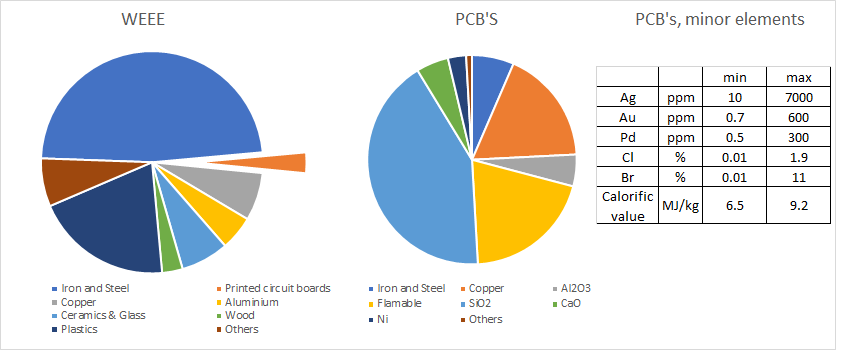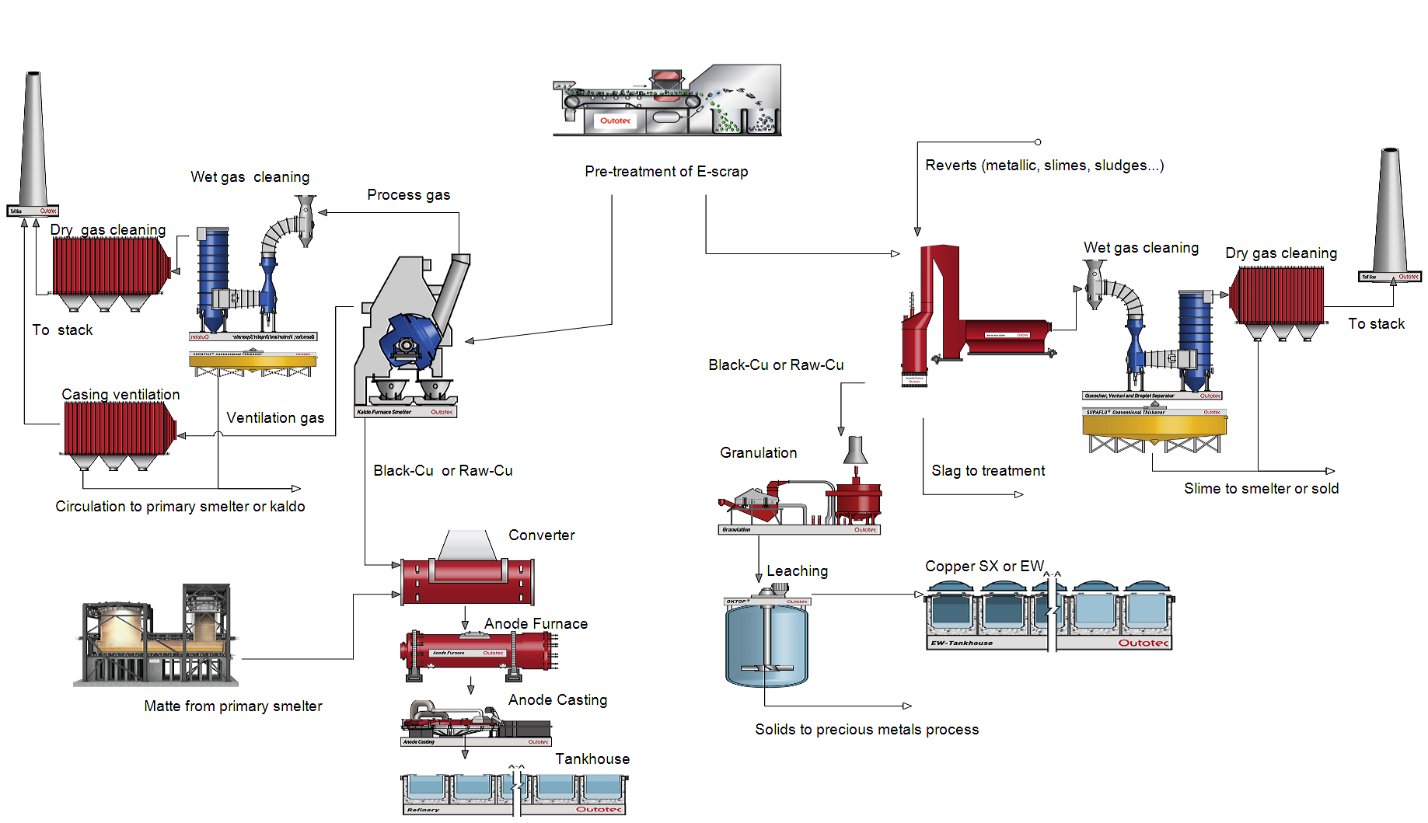A critical first step for processing WEEE after collection from consumers is separation or pre-processing of the different equipment into various fractions such as plastics, ferrous scrap, non-ferrous fractions, and printed circuit boards (PCBs). The term “e-scrap” is commonly used to describe the non-ferrous and PCB fractions that can be recycled in appropriately equipped smelters. Analysis of both WEEE and the PCB fraction of e-scrap is complex and subject to high variability as technology evolves (Figure 1).
Solutions for processing e-scrap

Our solutions
We offer a combination of industrially proven pyrometallurgical and hydrometallurgical processes to produce a variety of high-quality refined metal products from complex secondary copper raw materials in an efficient and environmentally friendly manner.
The processing of WEEE can be performed using different process combinations, as illustrated in Figure 2. The overall processing scheme of the copper-containing scrap may be integrated into the primary production line, in which the additional impurity load from secondary treatment may be diluted by the material flows of the primary smelter. Alternatively, WEEE processing can be performed on a stand-alone basis, where only secondary raw materials are treated to produce high-purity metal products.

The energy liberated by the combustion of plastics can be used to displace the need for additional fossil energy, which is required in the primary smelting of some concentrates. A significant challenge, on the other hand, can result from the volume and heat load of the plastic combustion gases on the smelter gas line, which is in many cases the limiting factor for established smelters. In addition, the potential formation of dioxin and furan by de-novo synthesis in the off-gas train of the smelter should be taken into account.
The Outotec Ausmelt process has been successfully applied to secondary copper recycling. Kosaka Smelting & Refining Co., Ltd. operate an Ausmelt smelter in Kosaka, Japan with a multi-stage bath smelting practice that treats a wide range of non-sulfide secondary feed materials. Another reference for the Outotec Ausmelt furnace for secondary copper smelting is GRM Co. Ltd, which started operating a secondary Ausmelt furnace in 2011 in Danyang, Korea. Both of these plants are located in countries with very strict local environmental regulations.
Another secondary copper treatment option from our portfolio is the Metso Outotec Kaldo process, which is a versatile technology that can be used for smelting and converting various secondary raw materials up to 100% of the charge. A Kaldo furnace for electronic scrap has been in use at the Boliden Rönnskär smelter in Sweden since 1980.
Secondary copper waste is commonly associated with various types of plastic-containing elements, which produce hazardous substances if processed in certain conditions. In addition to the possible formation of polychlorinated dioxide and furan compounds, different volatile metallic species (Pb, Hg, Cd, etc.) and dusts, halides, and possibly sulfur dioxide require treatment in the integrated off-gas line after the secondary smelting furnace. The integration of the most appropriate furnace-gas handling system is one of our areas of expertise. Metso Outotec gas-cleaning solutions range from dry/wet gas cleaning systems through to sulfuric acid production from sulfur dioxide-laden gas streams. The Metso Outotec Wet Gas Cleaning technology for e-scrap treatment is a reliable solution to remove solid particles, halides, and trace amounts of SO2 in the process gas, with efficient use of the required utilities. The formation of dioxin is minimized in the system design. The process gas is quenched, scrubbed, cooled, and filtered to efficiently remove pollutants such as dioxin mercury and sulfur.
The copper produced from smelting operations, together with associated precious metals, can be further refined by well-established hydrometallurgical processes. The determining factor in which hydrometallurgical processing route should be used is the quality of the pyrometallurgical copper intermediate, i.e. whether high-grade anode copper or lower-grade raw or black copper is to be refined. From high-grade anode copper, a standard electrorefining route can be utilized to produce high-grade copper cathode, together with precious metal refining from anode slime. If it is not economically viable to produce high-grade anodes, leaching raw copper followed by copper solvent extraction and electrowinning is another option. The main benefits of this process are higher tolerance towards impurities in the feed material and a more scalable investment. This processing technology also enables the same copper cathode quality and refining of precious metals as per the conventional electrorefining route.
By selecting the most appropriate combination of pyrometallurgical and hydrometallurgical processes, the plant scheme can be designed to optimize operational flexibility and economic performance, as well as enabling the treatment of e-scrap in a safe and environmentally friendly manner.